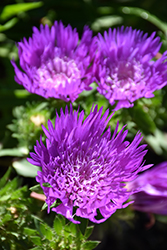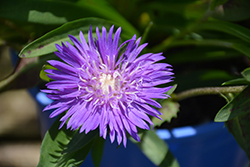Fri & Sat 8am - 8pm
Sun 8am - 7pm
Anytown, USA 12345
fax: 261.787.0463
e-mail: info@successgc.com


Plant Finder

Honeysong Purple Aster
Stokesia laevis 'Honeysong Purple'
Height: 12 inches
Spacing: 10 inches
Sunlight:
![]()
Hardiness Zone: 4b
Other Names: Stoke's Aster
Ornamental Features
Honeysong Purple Aster has masses of beautiful royal blue daisy flowers with violet overtones and white anthers held atop the stems from mid summer to early fall, which emerge from distinctive purple flower buds, and which are most effective when planted in groupings. The flowers are excellent for cutting. Its narrow leaves remain green in color throughout the year.
Landscape Attributes
Honeysong Purple Aster is a dense herbaceous evergreen perennial with a mounded form. Its relatively fine texture sets it apart from other garden plants with less refined foliage.
This is a relatively low maintenance plant, and is best cleaned up in early spring before it resumes active growth for the season. It is a good choice for attracting butterflies to your yard. It has no significant negative characteristics.
Honeysong Purple Aster is recommended for the following landscape applications;
- Mass Planting
- General Garden Use
Planting & Growing
Honeysong Purple Aster will grow to be about 10 inches tall at maturity, with a spread of 12 inches. When grown in masses or used as a bedding plant, individual plants should be spaced approximately 10 inches apart. Its foliage tends to remain low and dense right to the ground. It grows at a medium rate, and under ideal conditions can be expected to live for approximately 8 years. As an evegreen perennial, this plant will typically keep its form and foliage year-round.
This plant should only be grown in full sunlight. It does best in average to evenly moist conditions, but will not tolerate standing water. It is not particular as to soil type or pH. It is somewhat tolerant of urban pollution. Consider covering it with a thick layer of mulch in winter to protect it in exposed locations or colder microclimates. This is a selection of a native North American species. It can be propagated by division; however, as a cultivated variety, be aware that it may be subject to certain restrictions or prohibitions on propagation.

